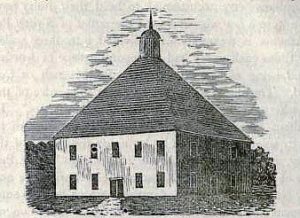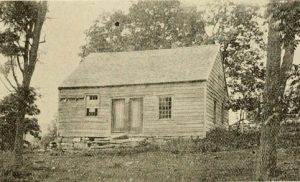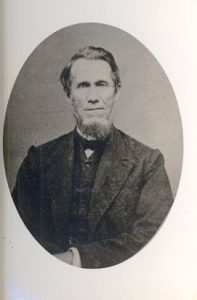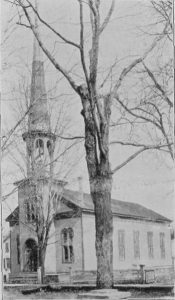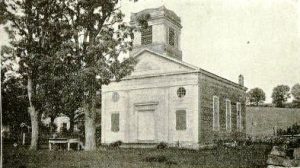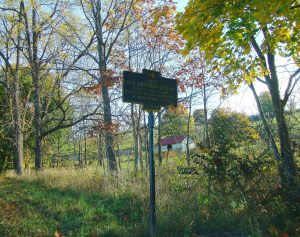
Shekomeko Mission Church
The first house of worship in Pine Plains was at Shekomeko, the Moravian mission and Mahican village, built in July of 1743 on what became Lot 12 in the deed of partition of the Little Nine Partners Patent. The building was 20 x 30 feet and was made of bark, the same material used by the Mahicans for their wigwam dwellings. At the time of its construction, the congregation here numbered sixty-three and included both Indians and white settlers. There was a native burying ground here used by the missionaries as well. The church stopped being used around the time of the mission closing in 1746 (see "The Moravian Mission at Shekomeko" page).
Round Top and Red Church
In 1746 after the demise of the mission, the German Lutheran settlers here, led by Michael Rowe and John Tice Smith, built a church called Round Top, also called Nine Partners, on an acre of land in Lot 30, about a mile from the mission site on what is now Carpenter Hill Road. This land was given to them by verbal promise of James Alexander, who owned a third of Lot 30 but who died before the gift to the Lutherans could be formalized.
We do not know exactly what this church looked like, but a short time later a Round Top church in Amenia Union (pictured) was constructed and it is thought the two churches were similar in appearance. In his history of Dutchess County, Philip H. Smith describes the Amenia Union church: "It was a capacious building, with galleries, and with doors on three sides. The roof had four sides, terminating at the top in an ornamental cupola."
Round Top in Pine Plains developed a close relationship with the Rhinebeck Lutheran churches. The first preacher is believed to have been Rev. John Christopher Hartwick (Johann Christoph Hartwig), who from 1746-1758 was the minister of St. Paul's Lutheran Church in Rhinebeck, also preaching at St. Peter's Lutheran Church in Rhinebeck (the "Old Stone Church") and in Ancram during this time. Called the "wandering bachelor", Hartwick was eccentric, a misogynist, and was generally not well liked by his congregations, to the extent that he had trouble finding employment and had to rely largely on charity to live. In a 1754 letter he complains about the abuses inflicted on him by his current congregation, including being attacked by a man, a woman, and a boy who trampled on his wig. However, in his will he bequeathed money for the establishment of a seminary in Cooperstown, New York. Hartwick Seminary was thus founded in 1797, the first Lutheran Seminary in America; when this closed, the proceeds were used to establish Hartwick College in Oneonta, New York.
Although Round Top was built by German Lutherans, some German Reformed worshiped here as well. The early sermons were all in German. It wasn't until 1769 that a deed to the land was finally given by James Alexander's son-in-law, Peter VanBrugh Livingston, which specified the ground "forever hereafter" to be used for a Lutheran church and churchyard. The Reformed parishioners left, taking the communion service with them, and in 1772 they established the Red Church on the highway about two miles east of the Pine Plains hamlet, named for its red paint.
The "Old Red Church" was used by the early settlers of Pulvers Corners. Like Round Top, it also established a close relationship with a church in Rhinebeck, in this case a German Reformed church, and its first preacher was from that church, Rev. Gerhard Daniel Koch. This led to the Red Church being called "Koch's Meeting House".
It is important to note the fortitude of the congregants and ministers from this time, who traveled great distances every Sabbath, usually on horseback and in all kinds of weather, to worship and to preach. A sad story passed down tells of a family fording the Shekomeko Creek on their way to their infant's baptism, during which the child fell into the water and drowned.
The Round Top church did not last very long, perhaps because of poor construction, and in 1780 a new church was built on the same site, also called Round Top. Thereafter, the original Round Top became known as "Old Round Top". We know that the second Round Top was 30 x 40 feet with 18 foot posts and benches for pews, and it was never finished off inside (common for this period). Between 1760 and 1788, there were 294 baptisms recorded at the two Round Top churches, a significant number. However, after the establishment of the Union Meeting House in the Pine Plains hamlet in 1816, in which Lutherans had 1/4 interest, attendance at the Round Top church began to fall off and finally in 1827 it was dismantled and the timber sold at auction.
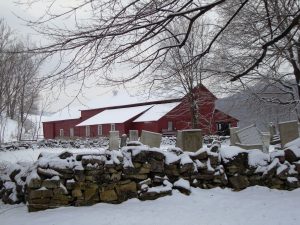
A plot of land on the east side of the road through the hamlet had been set aside as a burying ground for the descendants of Michael Rowe and became known as the Rowe Cemetery. On the west side of the road a cemetery designated "free for all burials" was also established. After the second Round Top was demolished in 1827, a boundary dispute arose between the descendants of Michael Rowe and a local landowner, Samuel Deuel, when the Rowe descendants tried to claim additional land to add to the cemetery. This went on for about two years until the skill of local lawyer Stephen Eno was enlisted to draw up an agreement where some land was exchanged to the satisfaction of both parties.

The Red Church also fell into decline around the same time as Round Top, many of the Reformed opting to either go to the Dutch Reformed church in Gallatin (the "Vedder" church), or the Union Meeting House in Pine Plains. It was torn down about 1826, and today only a few headstones in the small cemetery remain to mark where this house of worship once stood.
Quaker Meeting House
Although Quakers had been living in the area near Round Top for some time, it wasn't until Charles Hoag (1771-1840) settled here in 1799 and was given permission from the parent society at Stanford to hold meetings in his house that an organization began to take shape. Under the supervision of the Creek Meeting in Clinton Corners and the Nine Partners Meeting in Mechanic (a hamlet now known as South Millbrook), the North East Society was formed in 1803.
In 1806, Jacob Bockee deeded to the trustees of the society a plot of land for twenty-five dollars, and a 30 x 26 ft. meeting house with ten foot posts was built here on the Pine Plains-Amenia Road (County Rte. 83), opposite the Hoag dwelling and the road leading down into the hamlet (Carpenter Hill Road, or Bethel Road).
The separate entrances for men and women in Quaker meeting houses facilitated the interior separation, here by means of a high removable wooden partition, between men and women during business meetings, but worship was done together.
During North East Society's most prosperous years, from 1807 to about 1830, its membership increased to around 25. Preparative meetings were held here, which prepared business for the monthly and quarterly meetings at the Stanford parent society.
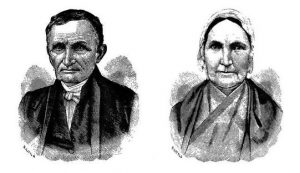
Charles Hoag was very active in town affairs, becoming Town Clerk of North East in 1800 and a school district trustee (Pine Plains at that time still being part of the town of North East, and the state having created the district school system in 1795). It is thought Hoag had a special interest in education, for in 1812 he established a Quaker boarding school for boys and girls at his home. Children who boarded came from surrounding towns, with day pupils from the immediate vicinity also attending. The first teachers were Jacob and Deborah Rodgers Willetts, a young couple who had attended and later taught at the Nine Partners Boarding School at Mechanic. Lucretia Mott, who would gain fame as an early feminist and abolitionist, was Deborah's pupil at Nine Partners. Hoag's school closed in 1824, and then it reopened briefly in 1835 as a finishing school for young ladies run by his daughter, Mary. Sadly, the Hoag dwelling was recently (2018) torn down.
Around the time of the demise of the school, the society here also began to decline, and in 1875, the meeting house property was sold to Phoenix Deuel. When the Pine Plains-Amenia Road was straightened in 1919, the meeting house was torn down. The Quaker burying ground with its few visible headstones, located on what had been the east side of the meeting house, is all that remains of the Quaker presence in this neighborhood.
Union Meeting House/Presbyterian Church
To satisfy the spiritual needs of the residents in the growing hamlet of Pine Plains, in 1813 four denominations - Presbyterian, Dutch Reformed, Lutheran, and Episcopalian - entered into "Articles of Association for the building of the Union Meeting House on Pine Plains". This was later amended to include all Christian denominations. In 1816, the Union Meeting House was built on the "Husted lot" which was purchased for one hundred and fifty dollars, and each denomination conducted its worship services here one Sunday a month. This was the first church in the Pine Plains hamlet.
One result of its formation was that people no longer needed to travel outside of the immediate community for worship, and churches in the outlying hamlets suffered from the decrease in attendance.
In 1820, an acre was purchased from the heirs of Peter Husted by the trustees of the meeting house for the hamlet's first burying ground (this is not counting an Indian burying ground that was said to have been where Pine Street is today). The meeting house's burying ground was laid out in lots and the trustees gave out the deeds. In 1852, it became part of the newly established Evergreen Cemetery and is located in that cemetery's southwest corner.
In 1833, Rev. William N. Sayre (1808-1896), a Presbyterian minister from Pleasant Valley, began preaching here, and in 1834 the first meeting of the Presbyterian Society, consisting of seven members, was held. This is considered the Presbyterian church’s beginning in Pine Plains, although a Rev. Barnum had been conducting Presbyterian services in the hamlet in various places since 1810. It was still a union meeting house and Rev. Sayre was preaching only one Sunday a month at this time. A bell was added to the meeting house in 1835, which was the first church bell in the community and rung for all occasions.
Finally, in 1847 resolutions were adopted that changed this house of worship from being a union meeting house to a Presbyterian church, with Rev. Sayre the stated minister.
Rev. Sayre became a pioneer in Presbyterianism in this region, and was involved in both the temperance and abolitionist movements. He was a member of the Dutchess County Anti-Slavery Society, which has fueled speculation that he was active with the Underground Railroad, but this has never been proven. It has been said that he was one of the most brilliant men to occupy a Dutchess County pulpit.
His pastorate lasted fifty years, until 1883.
In 1879, the church was significantly remodeled to appear as shown in the photo. In 1922, just one year into the forty-two year pastorate of Rev. Charles Moser, it was struck by lightening and was a total loss. The present stone church was dedicated in 1926.
This church is still active today.

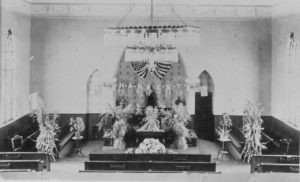
Methodist Church
The origin of Methodism begins in England in the 1730s with the Wesley brothers, Charles and John. What is interesting is that the Wesleys were heavily influenced by Moravian missionaries. In 1784, the Methodist Episcopal Church was formed in America.
Methodism spread to Pine Plains in 1789 when Benjamin Abbott, who was stationed on the Dutchess Circuit, traveled to Milan and Pine Plains, preaching “with great effect”. In those days, Methodists didn't meet in any one place; they met in homes, schoolhouses, shops, even outdoors in groves.
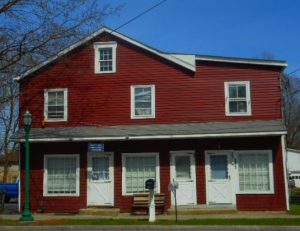
The original section of this building (pictured) on the east side of South Main Street was built around 1805 by Walter Mead, a Methodist and cabinet-maker, as a shop and also for a place to hold meetings; in 1830 it was moved to its current location and became a full-time shop.
In 1835, Dr. Benjamin S. Wilber, a Methodist, came to Pine Plains and settled on Halcyon Lake south of the hamlet (see "People" page). In 1837, due to his influence, an article of agreement was drawn up for the building of a Methodist Episcopal church in the Pine Plains hamlet for $1540, on land purchased from Dr. Cornelius Allerton two doors west of the Union Meeting House. The Rev. E.S. Stout was the first minister in the new church.
In 1871 the church was repaired and enlarged, and again in 1893. The steeple was removed in 1925 because it had become a safety concern. It is the oldest existing church building in the town of Pine Plains.
This church is still active today.
Baptist Church
The same year that the Methodist church was built, a Baptist church was built on the west corner of East Church and Pine Streets in the Pine Plains hamlet. This was the third church to be built on Church Street.
The Baptists had contributed to the building of the Union Meeting House and had expected to have a quarter share of the monthly worship, but this never happened. When the Baptist minister left after two years, the Baptist interest was transferred to the Dutch Reformed. For a period of time, the Pine Plains Baptists worshiped at the Baptist church in nearby Bangall.
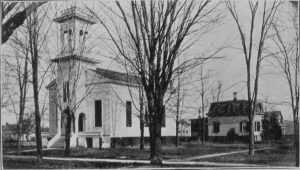
The organization of a Baptist church in Pine Plains came about largely through the efforts of Alfred Brush (?-1872), a tailor who lived in the old Graham log house (the Graham-Brush House today). In 1835, Brush and some neighbors had been baptized in the Shekomeko Creek at Hammertown, and in 1836 he hosted a meeting which incorporated the Baptist Society of Pine Plains with 26 members. In 1837 the church was built on a lot purchased from Elijah B. Northrup. The church was nearly completed when it was destroyed by a tornado. With the assistance of other Baptist churches throughout the county, the church was rebuilt early in 1838. The first minister was Elder Nathan D. Benedict, whose salary was $350 a year which included a house free of rent.
When Alfred Brush died the following memorandum was read in the church:
“Bro. Brush had been a very active deacon of the church from its organization. His piety like his mind was of a vigorous and unyielding stamp. He always did his own thinking, laid his own plans, and carried out as far as he could his conscientious and established conviction of duty. He loved the church next to his Saviour and gladly would he have made it a perfect church ‘without spot or wrinkle or any such thing’. For twenty years he had been an invalid, for five of the last nearly helpless. He saw without fear – with gladness even – his end approaching and met it in the vigor of faith and hope, aged eightsix.”
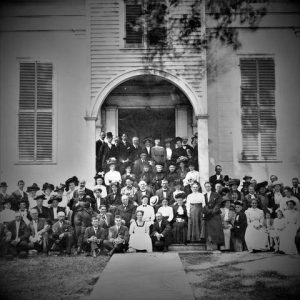
By the second half of the 1800s, the church was struggling and sometimes went for long periods without a regular minister. In 1932 the church was dissolved and in 1935 the building was sold to Pine Plains Grange #803, which had been without a permanent home since its organization in 1895. The Grange was here until around 1989; as the community became less rural, membership began to fall off and the remaining members from Pine Plains Grange merged with the Stanford Grange. The building is still standing.
Bethel Union Church
For the next church in Pine Plains we go back to the as yet unnamed hamlet where Round Top had been. We don't know where the members of this little community had been worshiping in the eleven years since the demise of Round Top (the Union Meeting House in the Pine Plains hamlet would have been closest) but in 1838 they decided that they wanted a local church again, this time a union church free to all denominations. The amount raised for the construction of the church, officially called Pine Plains Union Church, was $1069. Since many of the subscribers were also involved with the development of the Presbyterian, Methodist, and Baptist churches in the Pine Plains hamlet, our historian Huntting calls the widespread interest shown in this church remarkable and surmises that it was due to their reverence for the former Round Top. The land, originally part of the Round Top property, was donated by Samuel Deuel, and the church was completed in the winter of 1839-1840. It was 26 x 36 feet with 18 ft. posts.
Huntting relates a story about the raising of this church in an obituary he wrote for William Carman in 1908, which may seem amusing or quaint to us today. The Carman brothers had assisted in the raising, and Richard Carman (William's brother) performed a dedication ceremony, customary at the time, by standing on the top of the cupola with a bottle of water and announcing to all present,
"Here stands a high and lofty frame, The Christian temple is its name, The Christians all unite in one, Religion flow from sun to sun."
After this he swung the bottle over his head three times around, to the accompaniment of three cheers from the crowd, then threw the bottle to the middle of the road where it smashed to pieces.
A Lutheran minister was asked to come and do a more formal dedication, which was felt fitting since Round Top had been a Lutheran church, and it was from his use of Genesis 28:19 for the subject of his sermon that the name "Bethel" came about for both the church and the hamlet.
Everything seemed fine for a few years, and the ministers from the Pine Plains churches took turns preaching here.
In October of 1859 the Moravian monument was dedicated at the site of missionary Gottlieb Büttner's grave. People came from all over the town to take part in the festivities. As part of the day's events, a special worship service was held in the Bethel church led by a Moravian bishop and clergymen from Bethlehem, Pennsylvania. The Moravians are known for their music, so the church was filled with choral singing to the accompaniment of trombones. It was certainly one of the highlights in the life of this church.
However, trouble had been brewing in the community over the use of the church, something Huntting calls the "war of the Bethel church sectarian rebellion", probably influenced in his dramatic choice of words by the Civil War also brewing at that time.
So, what happened? While Huntting refused to elaborate on it in his history of Pine Plains, during the historical society's research for its Bethel publication we were able to uncover the mystery.
Although Episcopalians had early-on shared in the use of the Union Meeting House in Pine Plains, that denomination had pretty much died out in Pine Plains by the time the meeting house became a full-time Presbyterian church. However, there was renewed interest in having Episcopal services in the town after Theron Wilber (1804-1879), an Episcopalian, retired to Pine Plains from New York City in 1850, settling at the home of his brother, Dr. Benjamin Wilber, on Halcyon Lake. Dr. Wilber had been active in organizing the Methodist church in Pine Plains.
The Episcopalians began using the Bethel Union Church for regular services, which at first didn't cause a fuss since it was, after all, a union church. Theron Wilber was also one of the organizers of the monument dedication, as was Rev. Sheldon Davis, an Episcopal clergyman from Pleasant Valley, so Episcopalian influence in the area was growing. In 1858, the Right Rev. Horatio Potter confirmed three people in the Bethel church, the first act of confirmation in the town.
Then, in 1859 the Episcopalians decided to form a parish at the Bethel church, going so far as to elect officers and file a certificate of incorporation in the County Clerk's office. While this had worked out for the Presbyterians at the Union Meeting House in Pine Plains, it did not go over well in Bethel. When the congregation gathered together for their annual meeting at the church in 1860, they found themselves locked out of the building. The message for the Episcopalians couldn't have been clearer: they had gone too far. And while Bethel had been built as a union church, the controversy that ensued also brought out that it had been dedicated as a Lutheran church. Although we are left to speculate if angry words were exchanged over this whole matter, the Episcopalians decided it wasn't worth pursuing so they left Bethel and in 1861 built their own church in the Pine Plains hamlet, the Church of the Regeneration.
Unfortunately, the Bethel church never fully recovered from this quarrel with the Episcopalians. The church building continued to be maintained by the community, but services were few and far between. However, the Episcopalians regarded their time in the Bethel church fondly, in spite of the acrimony. In 1901, the Episcopal Church of the Regeneration in the Pine Plains hamlet began holding Sunday afternoon services at Bethel, and Mrs. Phoenix Deuel taught Sunday School classes for awhile. In 1902, they held a special service in the Bethel church to commemorate their brief time there half a century earlier.
On a Sunday afternoon in August of 1902, a "colored people's service" was held at the church, with H.M. Townsend, a black man from Millbrook, conducting the service.
In 1907, Briarcliff Farms bought and consolidated the small, independent farms in Bethel, and the church was opened up as a social center for the farm workers. Free night classes in English were provided for the Dutch-speaking workers, and entertainment was offered in the winter months. In 1911, a Thanksgiving feast attended by about one hundred employees was held there. After this, Sunday afternoon services resumed again for a few years, and then the record is silent. We are left to ponder when and how the church met its eventual demise.
Pulvers Corners Church
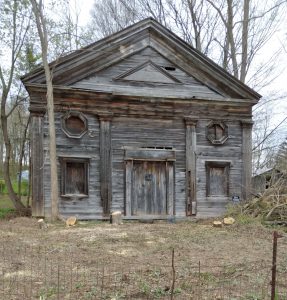
While all the controversy was swirling around in Bethel, the people in Pulvers Corners decided to build a union church right in their own hamlet. In 1853 or 1854, the church was built on land donated by William W. Pulver ("Uncle Helmus") for a cost of $1800, largely raised by subscriptions. It was 32 x 40 feet with a cupola which in 1865 was damaged by lightening and removed.
This church never had a regular minister, but Rev. William N. Sayre from the Presbyterian church in Pine Plains took an active role in its organization and regularly preached there. Sunday school classes were held here as well as community events. However, interest in worship at the church fell off, and eventually the building was sold. While it is still standing, it is in a serious state of disrepair, however the owner is currently renovating it.
Episcopal Church
The history of Episcopalianism in Pine Plains dates to a time around seventy years before the Bethel troubles, when in 1784 Ebenezer Dibblee, the son of an Episcopal minister, came from Sharon, Connecticut and settled in Pine Plains. However, the Dibblee family was without a place to worship here, and instead made what must have been an arduous journey every Sabbath back to their home church in Sharon, a distance of over fifteen miles. So, in 1816 when the Union Meeting House in Pine Plains was being built, the Dibblees, along with the Bostwicks and a few other Episcopalians in the town, made sure their contributions to its erection bought them a quarter share in the church. Cornelia Bostwick organized the first Sunday School in the hamlet there in 1822. The Dibblee and Bostwick families were what kept the Episcopalian share in the meeting house solvent, but by 1826 both families had moved away, and the remaining Episcopalians worshiped with the Presbyterians for about the next twenty-five years.
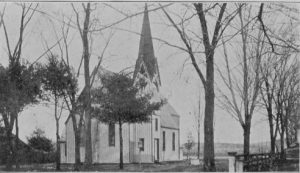
As has been stated, Theron Wilber set about establishing an Episcopal church in Pine Plains in the 1850s. After failing at Bethel, work was begun on building an Episcopal church in the Pine Plains hamlet. The church was completed in 1861 at a cost of $1845 on about an acre of land which cost an additional $430. The main building measured 28 x 52 feet. The first rector was Rev. F. E. Shober in 1887.
In 1905, a fire nearly destroyed the church; the newly installed water works in the hamlet, along with the quick action of the Pine Plains Hose Company, are credited with saving it.
This church is still active today.
Roman Catholic Church
As of the turn of the twentieth century, most people in Pine Plains were of a Reformed background and had never been exposed to the Catholic faith. Therefore a talk was held at the Bowman Opera House in 1902, open to both Catholics and non-Catholics, to acquaint people with Catholic doctrine. In those days, a circulating priest would come around and hold services on North Main Street, but as the population of Catholics in the town increased, interest in building a Catholic church grew.
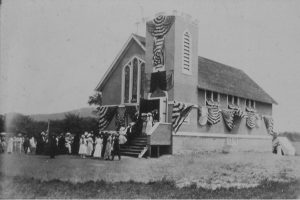
A building fund was begun, and the founding families were the Remsbergers and the Bartons, and Bill Fahey. The church, completed in 1913, was 30 x 60 feet and made of stucco with a tower and green shingles.
This church is still active today.
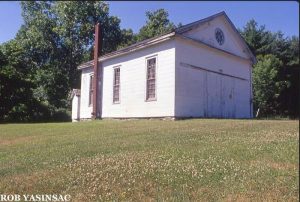
The Christian Church of Pine Plains
Once located on the Pine Plains end of Hicks Hill Road, this church was organized on November 7, 1858 at the house of Stephen Tomkins. The church was built by John W. Link in 1859 and dedicated by Eli Fay of Yellow Springs, Ohio on June 16, 1859. At one time the membership was sixty-two. The church was torn down by the Durst Corp. in the 2000s, but had long since been vacant.
Sources:
History of the Little Nine Partners, by Isaac Huntting, Chas. Walsh & Co., Amenia, NY, 1897.
History of Dutchess County, by James H. Smith, D. Mason & Co., Syracuse, NY, 1882.
Bible Hub: "John Christopher Hartwick"
WorldCat Indentities: "Hartwig, Johann Christoph"
The Pine Plains Register, The Pine Plains Herald, and The Register-Herald


